Indian Cancer Society: Breast Cancer Awareness and Prevention Report
VerifiedAdded on 2022/11/17
|9
|2486
|107
Report
AI Summary
This report provides an overview of the Indian Cancer Society's (ICS) role in addressing breast cancer in India. Founded in 1951, the ICS focuses on cancer awareness, detection, and medication, with an emphasis on breast cancer, which disproportionately affects women. The report highlights the organization's objectives, including providing cancer awareness, offering high-quality screening facilities at low cost, and providing financial assistance to patients. It discusses the background of breast cancer in India, including rising incidence rates, late-stage detection, and the influence of lifestyle factors. The report also examines the current efforts to improve breast cancer management, including the need for awareness, screening programs, and affordable treatment. Recommendations include increasing awareness, making screening accessible, providing affordable multimodality medication, and government support for community health centers and research. The report emphasizes the importance of early detection, screening, and community involvement in preventing breast cancer and improving the quality of life for patients.
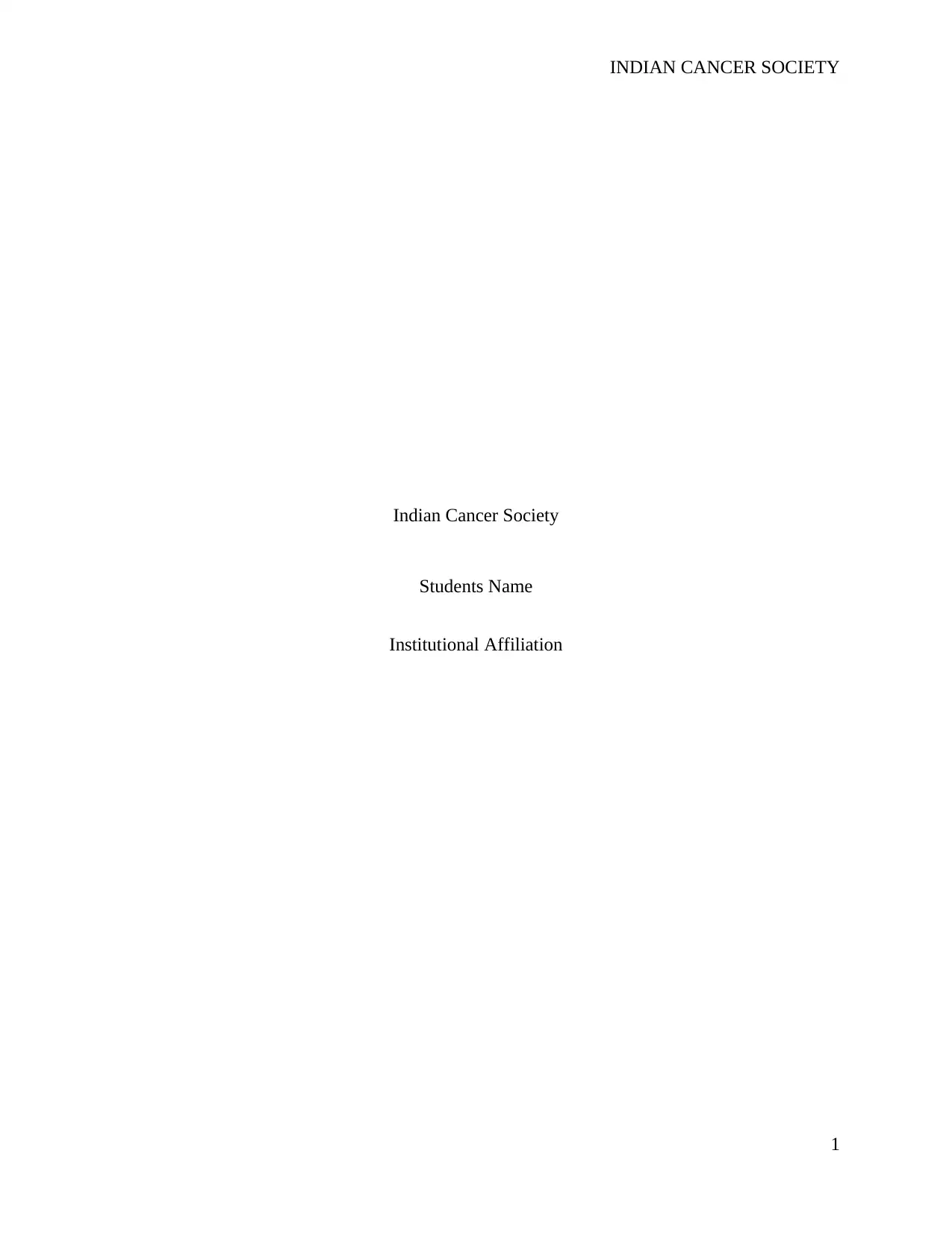
INDIAN CANCER SOCIETY
Indian Cancer Society
Students Name
Institutional Affiliation
1
Indian Cancer Society
Students Name
Institutional Affiliation
1
Paraphrase This Document
Need a fresh take? Get an instant paraphrase of this document with our AI Paraphraser
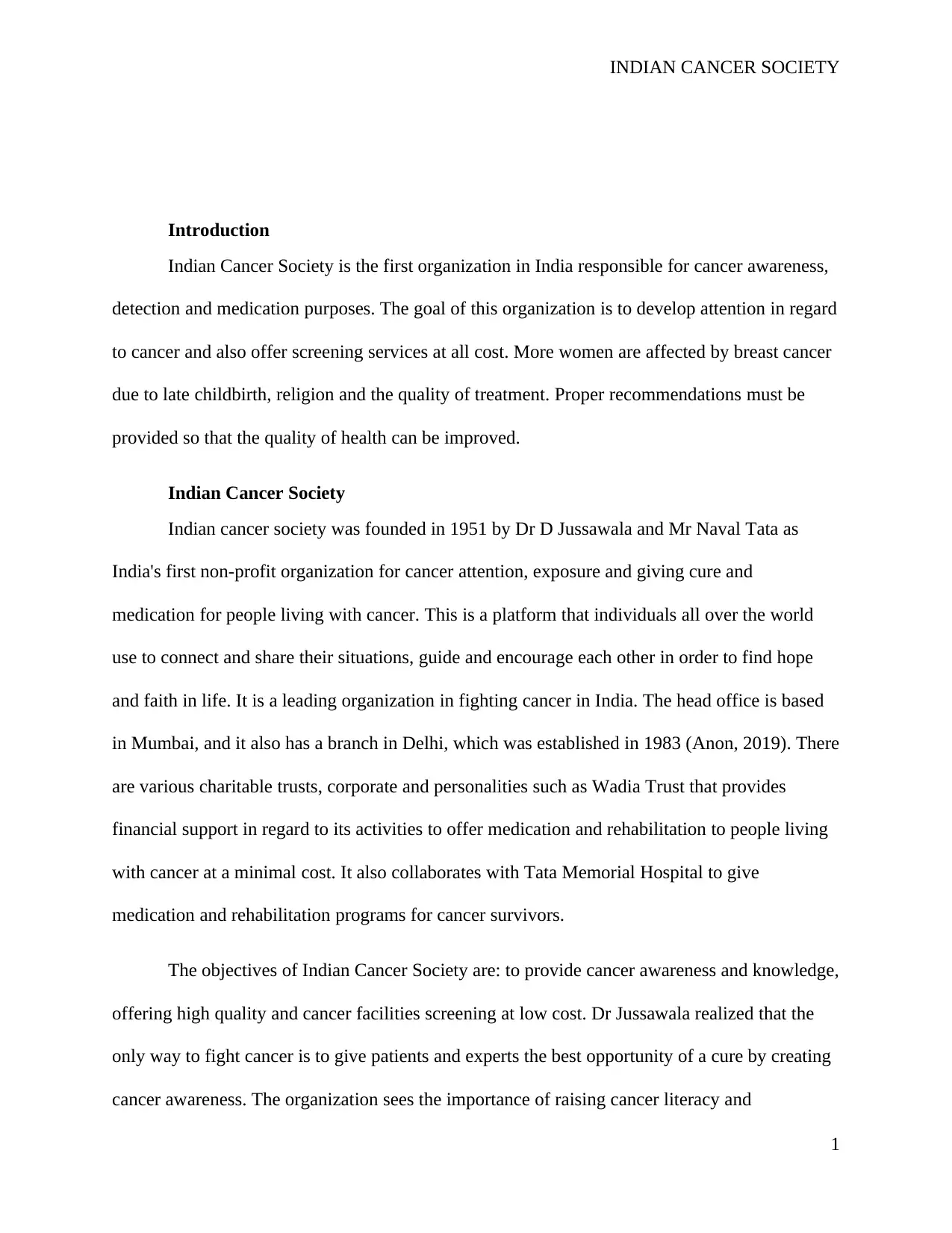
INDIAN CANCER SOCIETY
Introduction
Indian Cancer Society is the first organization in India responsible for cancer awareness,
detection and medication purposes. The goal of this organization is to develop attention in regard
to cancer and also offer screening services at all cost. More women are affected by breast cancer
due to late childbirth, religion and the quality of treatment. Proper recommendations must be
provided so that the quality of health can be improved.
Indian Cancer Society
Indian cancer society was founded in 1951 by Dr D Jussawala and Mr Naval Tata as
India's first non-profit organization for cancer attention, exposure and giving cure and
medication for people living with cancer. This is a platform that individuals all over the world
use to connect and share their situations, guide and encourage each other in order to find hope
and faith in life. It is a leading organization in fighting cancer in India. The head office is based
in Mumbai, and it also has a branch in Delhi, which was established in 1983 (Anon, 2019). There
are various charitable trusts, corporate and personalities such as Wadia Trust that provides
financial support in regard to its activities to offer medication and rehabilitation to people living
with cancer at a minimal cost. It also collaborates with Tata Memorial Hospital to give
medication and rehabilitation programs for cancer survivors.
The objectives of Indian Cancer Society are: to provide cancer awareness and knowledge,
offering high quality and cancer facilities screening at low cost. Dr Jussawala realized that the
only way to fight cancer is to give patients and experts the best opportunity of a cure by creating
cancer awareness. The organization sees the importance of raising cancer literacy and
1
Introduction
Indian Cancer Society is the first organization in India responsible for cancer awareness,
detection and medication purposes. The goal of this organization is to develop attention in regard
to cancer and also offer screening services at all cost. More women are affected by breast cancer
due to late childbirth, religion and the quality of treatment. Proper recommendations must be
provided so that the quality of health can be improved.
Indian Cancer Society
Indian cancer society was founded in 1951 by Dr D Jussawala and Mr Naval Tata as
India's first non-profit organization for cancer attention, exposure and giving cure and
medication for people living with cancer. This is a platform that individuals all over the world
use to connect and share their situations, guide and encourage each other in order to find hope
and faith in life. It is a leading organization in fighting cancer in India. The head office is based
in Mumbai, and it also has a branch in Delhi, which was established in 1983 (Anon, 2019). There
are various charitable trusts, corporate and personalities such as Wadia Trust that provides
financial support in regard to its activities to offer medication and rehabilitation to people living
with cancer at a minimal cost. It also collaborates with Tata Memorial Hospital to give
medication and rehabilitation programs for cancer survivors.
The objectives of Indian Cancer Society are: to provide cancer awareness and knowledge,
offering high quality and cancer facilities screening at low cost. Dr Jussawala realized that the
only way to fight cancer is to give patients and experts the best opportunity of a cure by creating
cancer awareness. The organization sees the importance of raising cancer literacy and
1

INDIAN CANCER SOCIETY
knowledge. It is essential to provide information to individuals regarding signs and symptoms
early enough hence making them to seek assistance immediately. It creates awareness through
different programs like awareness talks done in institutions and society, videos that are
informative and posts using social media, academic films for breast, cervical and oral cancers.
The organization also screens for early detection since various cancers are manageable when
they are unmasked early and medicated appropriately. There is also a Cancer Cure Fund that
gives financial assistance for cancer patients who are unable to pay their hospital bills.
Background to health issues
More women have cancer than any other cancer besides skin cancer. About 6% of
women are diagnosed with metastatic cancer are first diagnosed with breast cancer. Breast cancer
is the second most usual cause of death globally. However, the number has reduced due to early
detection and medication enhancements. In addition, it is not easy to prevent breast cancer.
Breast cancer affects Indian women at a young age compared to western women. It is rising, but
it is low in India (Finn et al. 2016, pp.1925-1936). It is also the most prevalent cancer of urban
Indian females followed by rural females. The majority of breast cancers are always identified at
an advanced stage due to the lack of attention and lack of breast cancer screening program of
breast cancer. Furthermore, breast cancer in India has been known to happen a decade earlier in
Indian guardians compared to the western women.
Marriage at an early stage and breastfeeding of all children for a long period is the
normality in India. Those who are in urban areas are educated moving away from this tendency
with late-age childbirth and minimal or no breastfeeding. These transitions might be partly
responsible for the increasing rate of breast cancer incidence (Early Breast Cancer Trialists'
Collaborative Group, 2015, pp.1353-1361). Nulliparity and giving birth late are the risk elements
1
knowledge. It is essential to provide information to individuals regarding signs and symptoms
early enough hence making them to seek assistance immediately. It creates awareness through
different programs like awareness talks done in institutions and society, videos that are
informative and posts using social media, academic films for breast, cervical and oral cancers.
The organization also screens for early detection since various cancers are manageable when
they are unmasked early and medicated appropriately. There is also a Cancer Cure Fund that
gives financial assistance for cancer patients who are unable to pay their hospital bills.
Background to health issues
More women have cancer than any other cancer besides skin cancer. About 6% of
women are diagnosed with metastatic cancer are first diagnosed with breast cancer. Breast cancer
is the second most usual cause of death globally. However, the number has reduced due to early
detection and medication enhancements. In addition, it is not easy to prevent breast cancer.
Breast cancer affects Indian women at a young age compared to western women. It is rising, but
it is low in India (Finn et al. 2016, pp.1925-1936). It is also the most prevalent cancer of urban
Indian females followed by rural females. The majority of breast cancers are always identified at
an advanced stage due to the lack of attention and lack of breast cancer screening program of
breast cancer. Furthermore, breast cancer in India has been known to happen a decade earlier in
Indian guardians compared to the western women.
Marriage at an early stage and breastfeeding of all children for a long period is the
normality in India. Those who are in urban areas are educated moving away from this tendency
with late-age childbirth and minimal or no breastfeeding. These transitions might be partly
responsible for the increasing rate of breast cancer incidence (Early Breast Cancer Trialists'
Collaborative Group, 2015, pp.1353-1361). Nulliparity and giving birth late are the risk elements
1
⊘ This is a preview!⊘
Do you want full access?
Subscribe today to unlock all pages.

Trusted by 1+ million students worldwide
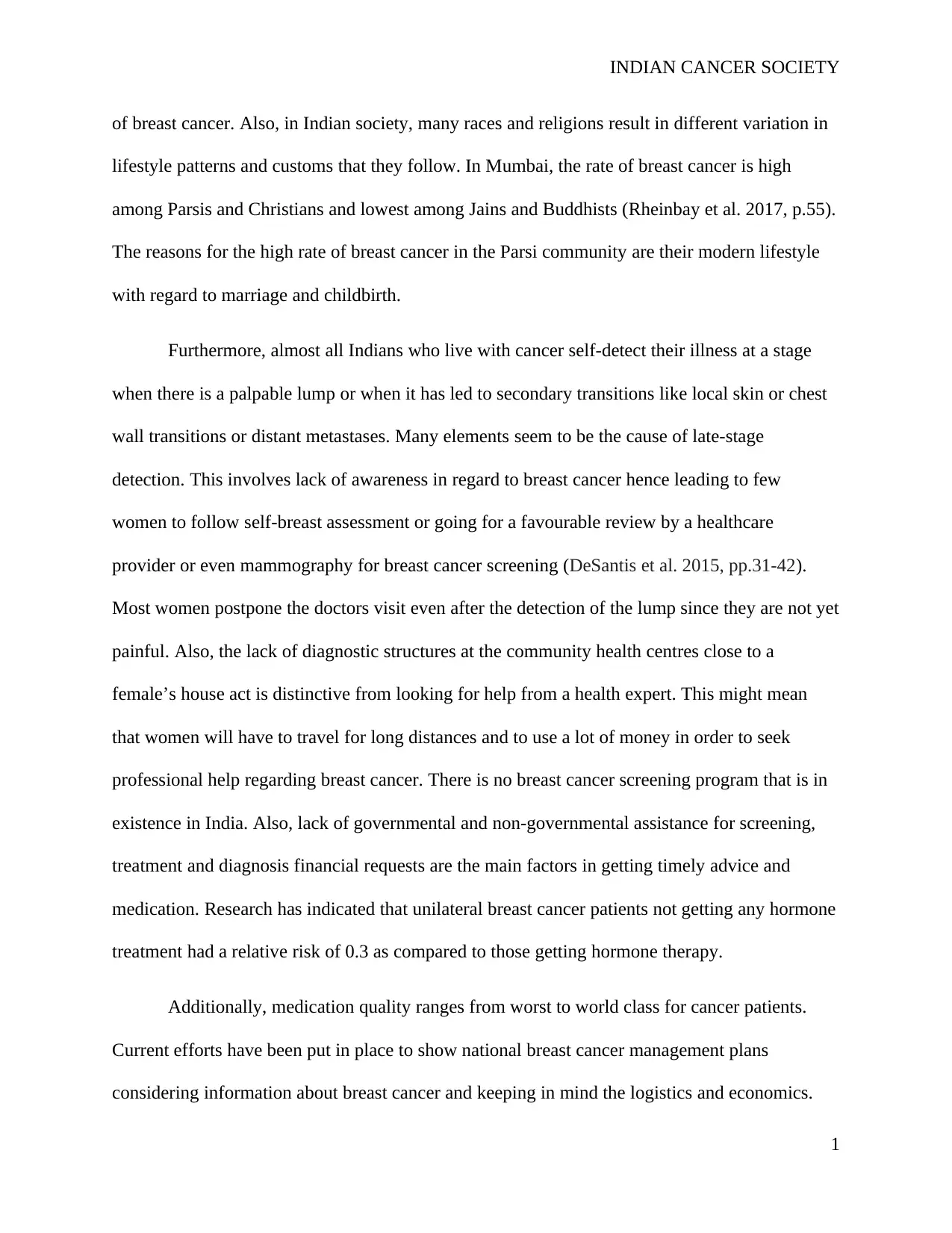
INDIAN CANCER SOCIETY
of breast cancer. Also, in Indian society, many races and religions result in different variation in
lifestyle patterns and customs that they follow. In Mumbai, the rate of breast cancer is high
among Parsis and Christians and lowest among Jains and Buddhists (Rheinbay et al. 2017, p.55).
The reasons for the high rate of breast cancer in the Parsi community are their modern lifestyle
with regard to marriage and childbirth.
Furthermore, almost all Indians who live with cancer self-detect their illness at a stage
when there is a palpable lump or when it has led to secondary transitions like local skin or chest
wall transitions or distant metastases. Many elements seem to be the cause of late-stage
detection. This involves lack of awareness in regard to breast cancer hence leading to few
women to follow self-breast assessment or going for a favourable review by a healthcare
provider or even mammography for breast cancer screening (DeSantis et al. 2015, pp.31-42).
Most women postpone the doctors visit even after the detection of the lump since they are not yet
painful. Also, the lack of diagnostic structures at the community health centres close to a
female’s house act is distinctive from looking for help from a health expert. This might mean
that women will have to travel for long distances and to use a lot of money in order to seek
professional help regarding breast cancer. There is no breast cancer screening program that is in
existence in India. Also, lack of governmental and non-governmental assistance for screening,
treatment and diagnosis financial requests are the main factors in getting timely advice and
medication. Research has indicated that unilateral breast cancer patients not getting any hormone
treatment had a relative risk of 0.3 as compared to those getting hormone therapy.
Additionally, medication quality ranges from worst to world class for cancer patients.
Current efforts have been put in place to show national breast cancer management plans
considering information about breast cancer and keeping in mind the logistics and economics.
1
of breast cancer. Also, in Indian society, many races and religions result in different variation in
lifestyle patterns and customs that they follow. In Mumbai, the rate of breast cancer is high
among Parsis and Christians and lowest among Jains and Buddhists (Rheinbay et al. 2017, p.55).
The reasons for the high rate of breast cancer in the Parsi community are their modern lifestyle
with regard to marriage and childbirth.
Furthermore, almost all Indians who live with cancer self-detect their illness at a stage
when there is a palpable lump or when it has led to secondary transitions like local skin or chest
wall transitions or distant metastases. Many elements seem to be the cause of late-stage
detection. This involves lack of awareness in regard to breast cancer hence leading to few
women to follow self-breast assessment or going for a favourable review by a healthcare
provider or even mammography for breast cancer screening (DeSantis et al. 2015, pp.31-42).
Most women postpone the doctors visit even after the detection of the lump since they are not yet
painful. Also, the lack of diagnostic structures at the community health centres close to a
female’s house act is distinctive from looking for help from a health expert. This might mean
that women will have to travel for long distances and to use a lot of money in order to seek
professional help regarding breast cancer. There is no breast cancer screening program that is in
existence in India. Also, lack of governmental and non-governmental assistance for screening,
treatment and diagnosis financial requests are the main factors in getting timely advice and
medication. Research has indicated that unilateral breast cancer patients not getting any hormone
treatment had a relative risk of 0.3 as compared to those getting hormone therapy.
Additionally, medication quality ranges from worst to world class for cancer patients.
Current efforts have been put in place to show national breast cancer management plans
considering information about breast cancer and keeping in mind the logistics and economics.
1
Paraphrase This Document
Need a fresh take? Get an instant paraphrase of this document with our AI Paraphraser

INDIAN CANCER SOCIETY
Breast cancer treatment is ascertained by many elements besides the guardians’ outlook, which
might encompass the lives of the patients within the reach and affordable medication (Whelan et
al. 2015, pp.307-316). There are few victims treated at facilities which are well-equipped in a
protocol-based manner with various adjustments made in multimodality therapy depending on
elements like inadequate nutrition, economics and tolerance, among others. Poor compliance to
medication and follow-up is because of stigmatization and expensiveness of the medication.
Recommendations
Generating awareness regarding breast cancer risk elements such as early identification
and making screening available to all people at risk, giving multimodality medication available
to many individuals at an affordable cost in the following years (Siu 2016, pp.279-296). The
government must work with health practitioners and establish community health centres where
people can have easy access to health services. This will help in spreading knowledge to all
people so that they can be aware of the dangers of cancer and help them take adequate measures
so that they can prevent breast cancer. Also, the government must work together with hospitals
and hold seminars and workshops where the community members communicate with health
experts and ask questions about breast cancer. It is essential to focus on the needs of the
community and equip them with the knowledge that will help them in making sure that they live
a healthy life. Through community events, individuals are able to get first-hand information
regarding breast cancer. The community must be willing to participate in these events since they
provide the required information.
Also, individuals are encouraged to go for early screening so that breast cancer can be
detected early enough. This will help people to seek first treatment so that they can promote a
healthy lifestyle. The objective of screening tests is to detect cancer at an early stage when it can
1
Breast cancer treatment is ascertained by many elements besides the guardians’ outlook, which
might encompass the lives of the patients within the reach and affordable medication (Whelan et
al. 2015, pp.307-316). There are few victims treated at facilities which are well-equipped in a
protocol-based manner with various adjustments made in multimodality therapy depending on
elements like inadequate nutrition, economics and tolerance, among others. Poor compliance to
medication and follow-up is because of stigmatization and expensiveness of the medication.
Recommendations
Generating awareness regarding breast cancer risk elements such as early identification
and making screening available to all people at risk, giving multimodality medication available
to many individuals at an affordable cost in the following years (Siu 2016, pp.279-296). The
government must work with health practitioners and establish community health centres where
people can have easy access to health services. This will help in spreading knowledge to all
people so that they can be aware of the dangers of cancer and help them take adequate measures
so that they can prevent breast cancer. Also, the government must work together with hospitals
and hold seminars and workshops where the community members communicate with health
experts and ask questions about breast cancer. It is essential to focus on the needs of the
community and equip them with the knowledge that will help them in making sure that they live
a healthy life. Through community events, individuals are able to get first-hand information
regarding breast cancer. The community must be willing to participate in these events since they
provide the required information.
Also, individuals are encouraged to go for early screening so that breast cancer can be
detected early enough. This will help people to seek first treatment so that they can promote a
healthy lifestyle. The objective of screening tests is to detect cancer at an early stage when it can
1
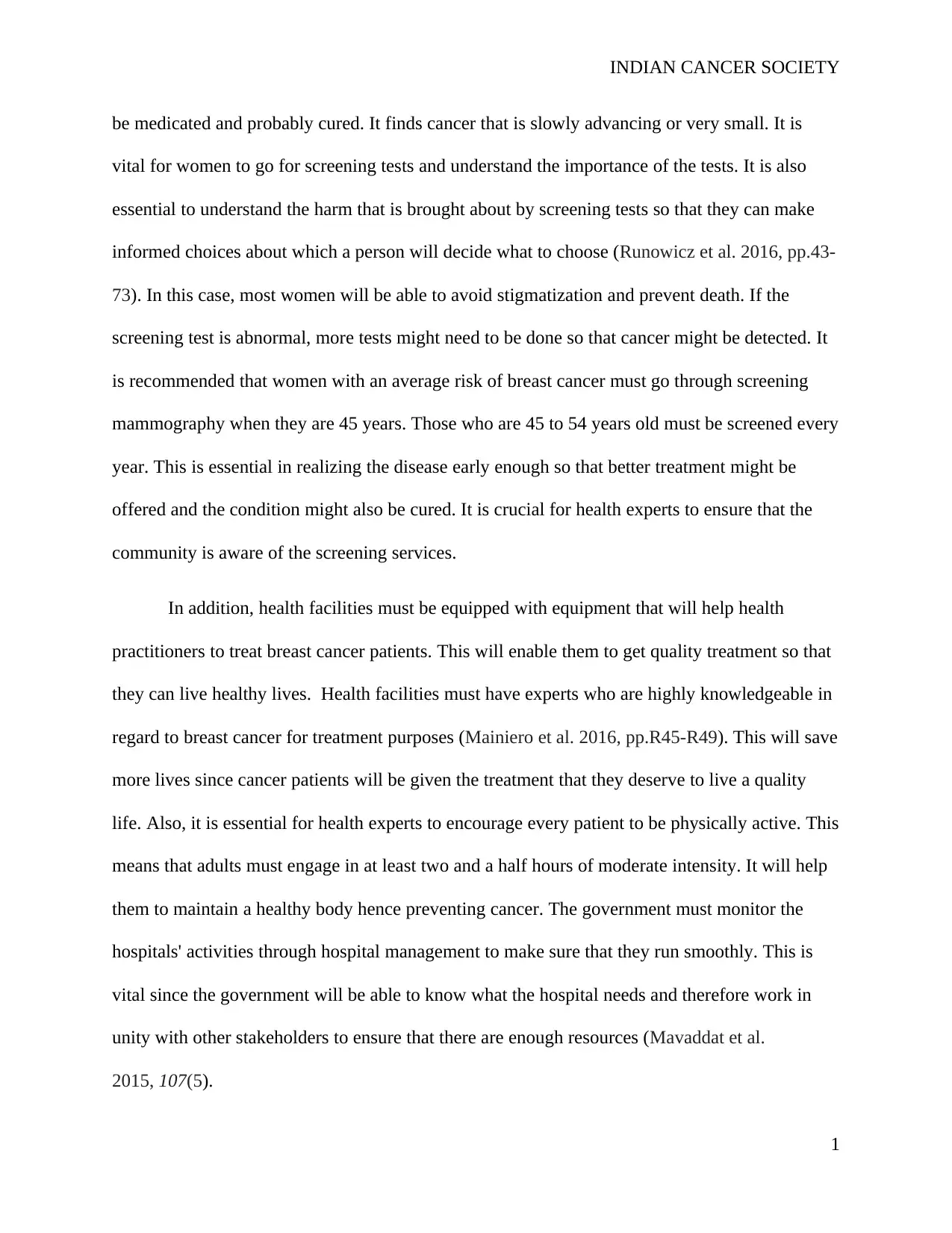
INDIAN CANCER SOCIETY
be medicated and probably cured. It finds cancer that is slowly advancing or very small. It is
vital for women to go for screening tests and understand the importance of the tests. It is also
essential to understand the harm that is brought about by screening tests so that they can make
informed choices about which a person will decide what to choose (Runowicz et al. 2016, pp.43-
73). In this case, most women will be able to avoid stigmatization and prevent death. If the
screening test is abnormal, more tests might need to be done so that cancer might be detected. It
is recommended that women with an average risk of breast cancer must go through screening
mammography when they are 45 years. Those who are 45 to 54 years old must be screened every
year. This is essential in realizing the disease early enough so that better treatment might be
offered and the condition might also be cured. It is crucial for health experts to ensure that the
community is aware of the screening services.
In addition, health facilities must be equipped with equipment that will help health
practitioners to treat breast cancer patients. This will enable them to get quality treatment so that
they can live healthy lives. Health facilities must have experts who are highly knowledgeable in
regard to breast cancer for treatment purposes (Mainiero et al. 2016, pp.R45-R49). This will save
more lives since cancer patients will be given the treatment that they deserve to live a quality
life. Also, it is essential for health experts to encourage every patient to be physically active. This
means that adults must engage in at least two and a half hours of moderate intensity. It will help
them to maintain a healthy body hence preventing cancer. The government must monitor the
hospitals' activities through hospital management to make sure that they run smoothly. This is
vital since the government will be able to know what the hospital needs and therefore work in
unity with other stakeholders to ensure that there are enough resources (Mavaddat et al.
2015, 107(5).
1
be medicated and probably cured. It finds cancer that is slowly advancing or very small. It is
vital for women to go for screening tests and understand the importance of the tests. It is also
essential to understand the harm that is brought about by screening tests so that they can make
informed choices about which a person will decide what to choose (Runowicz et al. 2016, pp.43-
73). In this case, most women will be able to avoid stigmatization and prevent death. If the
screening test is abnormal, more tests might need to be done so that cancer might be detected. It
is recommended that women with an average risk of breast cancer must go through screening
mammography when they are 45 years. Those who are 45 to 54 years old must be screened every
year. This is essential in realizing the disease early enough so that better treatment might be
offered and the condition might also be cured. It is crucial for health experts to ensure that the
community is aware of the screening services.
In addition, health facilities must be equipped with equipment that will help health
practitioners to treat breast cancer patients. This will enable them to get quality treatment so that
they can live healthy lives. Health facilities must have experts who are highly knowledgeable in
regard to breast cancer for treatment purposes (Mainiero et al. 2016, pp.R45-R49). This will save
more lives since cancer patients will be given the treatment that they deserve to live a quality
life. Also, it is essential for health experts to encourage every patient to be physically active. This
means that adults must engage in at least two and a half hours of moderate intensity. It will help
them to maintain a healthy body hence preventing cancer. The government must monitor the
hospitals' activities through hospital management to make sure that they run smoothly. This is
vital since the government will be able to know what the hospital needs and therefore work in
unity with other stakeholders to ensure that there are enough resources (Mavaddat et al.
2015, 107(5).
1
⊘ This is a preview!⊘
Do you want full access?
Subscribe today to unlock all pages.

Trusted by 1+ million students worldwide
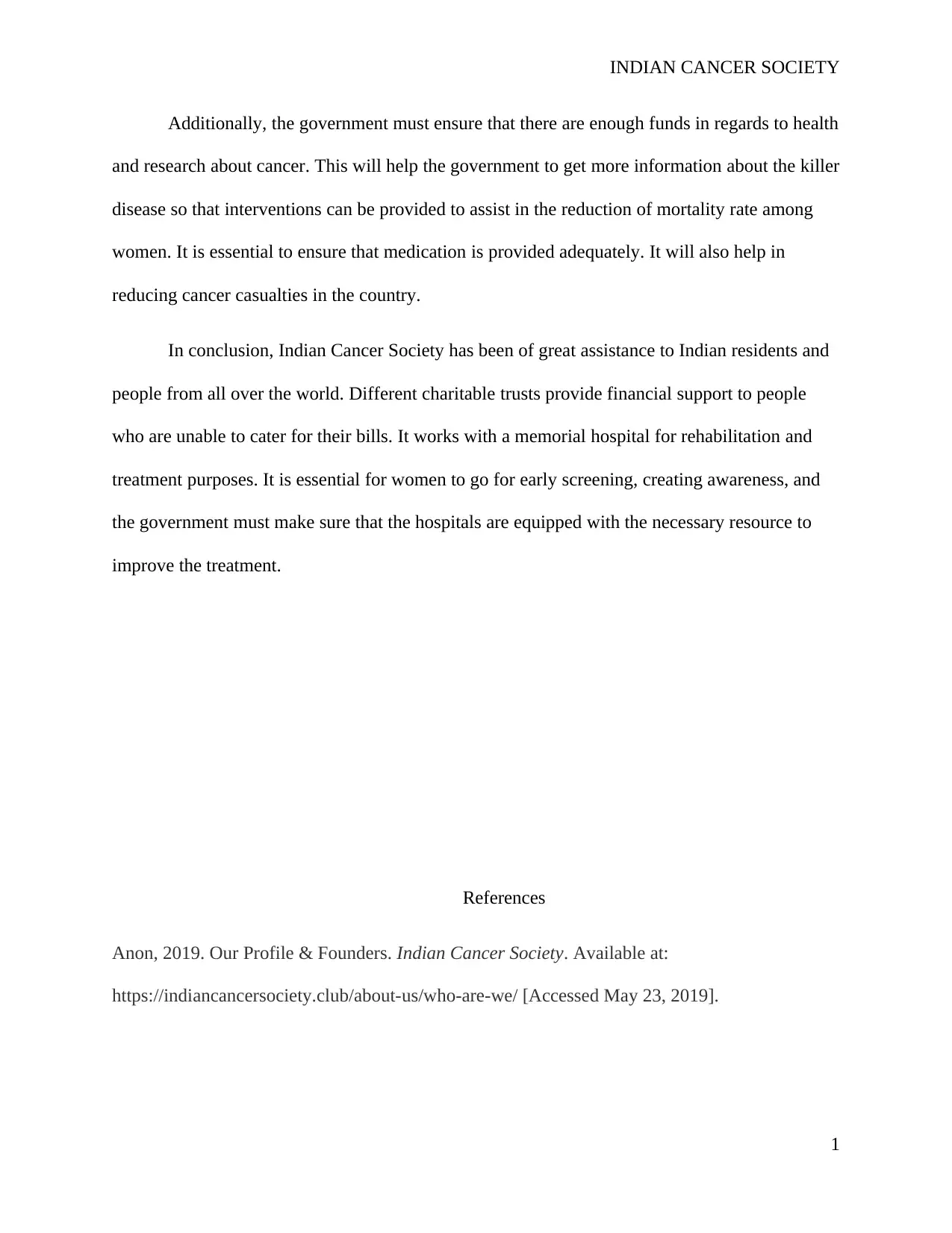
INDIAN CANCER SOCIETY
Additionally, the government must ensure that there are enough funds in regards to health
and research about cancer. This will help the government to get more information about the killer
disease so that interventions can be provided to assist in the reduction of mortality rate among
women. It is essential to ensure that medication is provided adequately. It will also help in
reducing cancer casualties in the country.
In conclusion, Indian Cancer Society has been of great assistance to Indian residents and
people from all over the world. Different charitable trusts provide financial support to people
who are unable to cater for their bills. It works with a memorial hospital for rehabilitation and
treatment purposes. It is essential for women to go for early screening, creating awareness, and
the government must make sure that the hospitals are equipped with the necessary resource to
improve the treatment.
References
Anon, 2019. Our Profile & Founders. Indian Cancer Society. Available at:
https://indiancancersociety.club/about-us/who-are-we/ [Accessed May 23, 2019].
1
Additionally, the government must ensure that there are enough funds in regards to health
and research about cancer. This will help the government to get more information about the killer
disease so that interventions can be provided to assist in the reduction of mortality rate among
women. It is essential to ensure that medication is provided adequately. It will also help in
reducing cancer casualties in the country.
In conclusion, Indian Cancer Society has been of great assistance to Indian residents and
people from all over the world. Different charitable trusts provide financial support to people
who are unable to cater for their bills. It works with a memorial hospital for rehabilitation and
treatment purposes. It is essential for women to go for early screening, creating awareness, and
the government must make sure that the hospitals are equipped with the necessary resource to
improve the treatment.
References
Anon, 2019. Our Profile & Founders. Indian Cancer Society. Available at:
https://indiancancersociety.club/about-us/who-are-we/ [Accessed May 23, 2019].
1
Paraphrase This Document
Need a fresh take? Get an instant paraphrase of this document with our AI Paraphraser

INDIAN CANCER SOCIETY
DeSantis, C.E., Fedewa, S.A., Goding Sauer, A., Kramer, J.L., Smith, R.A. and Jemal, A. Breast
cancer statistics, 2015: Convergence of incidence rates between black and white women. CA: a
cancer journal for clinicians, 66(1), pp.31-42.
Early Breast Cancer Trialists' Collaborative Group, 2015. Adjuvant bisphosphonate treatment in
early breast cancer: meta-analyses of individual patient data from randomised trials. The
Lancet, 386(10001), pp.1353-1361.
Finn, R.S., Martin, M., Rugo, H.S., Jones, S., Im, S.A., Gelmon, K., Harbeck, N., Lipatov, O.N.,
Walshe, J.M., Moulder, S. and Gauthier, E., 2016. Palbociclib and letrozole in advanced breast
cancer. New England Journal of Medicine, 375(20), pp.1925-1936.
Mainiero, M.B., Lourenco, A., Mahoney, M.C., Newell, M.S., Bailey, L., Barke, L.D., D’Orsi,
C., Harvey, J.A., Hayes, M.K., Huynh, P.T. and Jokich, P.M., 2016. ACR appropriateness
criteria breast cancer screening. Journal of the American College of Radiology, 13(11), pp.R45-
R49.
Mavaddat, N., Pharoah, P.D., Michailidou, K., Tyrer, J., Brook, M.N., Bolla, M.K., Wang, Q.,
Dennis, J., Dunning, A.M., Shah, M. and Luben, R., 2015. Prediction of breast cancer risk based
on profiling with common genetic variants. JNCI: Journal of the National Cancer
Institute, 107(5).
Rheinbay, E., Parasuraman, P., Grimsby, J., Tiao, G., Engreitz, J.M., Kim, J., Lawrence, M.S.,
Taylor-Weiner, A., Rodriguez-Cuevas, S., Rosenberg, M. and Hess, J., 2017. Recurrent and
functional regulatory mutations in breast cancer. Nature, 547(7661), p.55.
Runowicz, C.D., Leach, C.R., Henry, N.L., Henry, K.S., Mackey, H.T., Cowens‐Alvarado, R.L.,
Cannady, R.S., Pratt‐Chapman, M.L., Edge, S.B., Jacobs, L.A. and Hurria, A., 2016. American
1
DeSantis, C.E., Fedewa, S.A., Goding Sauer, A., Kramer, J.L., Smith, R.A. and Jemal, A. Breast
cancer statistics, 2015: Convergence of incidence rates between black and white women. CA: a
cancer journal for clinicians, 66(1), pp.31-42.
Early Breast Cancer Trialists' Collaborative Group, 2015. Adjuvant bisphosphonate treatment in
early breast cancer: meta-analyses of individual patient data from randomised trials. The
Lancet, 386(10001), pp.1353-1361.
Finn, R.S., Martin, M., Rugo, H.S., Jones, S., Im, S.A., Gelmon, K., Harbeck, N., Lipatov, O.N.,
Walshe, J.M., Moulder, S. and Gauthier, E., 2016. Palbociclib and letrozole in advanced breast
cancer. New England Journal of Medicine, 375(20), pp.1925-1936.
Mainiero, M.B., Lourenco, A., Mahoney, M.C., Newell, M.S., Bailey, L., Barke, L.D., D’Orsi,
C., Harvey, J.A., Hayes, M.K., Huynh, P.T. and Jokich, P.M., 2016. ACR appropriateness
criteria breast cancer screening. Journal of the American College of Radiology, 13(11), pp.R45-
R49.
Mavaddat, N., Pharoah, P.D., Michailidou, K., Tyrer, J., Brook, M.N., Bolla, M.K., Wang, Q.,
Dennis, J., Dunning, A.M., Shah, M. and Luben, R., 2015. Prediction of breast cancer risk based
on profiling with common genetic variants. JNCI: Journal of the National Cancer
Institute, 107(5).
Rheinbay, E., Parasuraman, P., Grimsby, J., Tiao, G., Engreitz, J.M., Kim, J., Lawrence, M.S.,
Taylor-Weiner, A., Rodriguez-Cuevas, S., Rosenberg, M. and Hess, J., 2017. Recurrent and
functional regulatory mutations in breast cancer. Nature, 547(7661), p.55.
Runowicz, C.D., Leach, C.R., Henry, N.L., Henry, K.S., Mackey, H.T., Cowens‐Alvarado, R.L.,
Cannady, R.S., Pratt‐Chapman, M.L., Edge, S.B., Jacobs, L.A. and Hurria, A., 2016. American
1
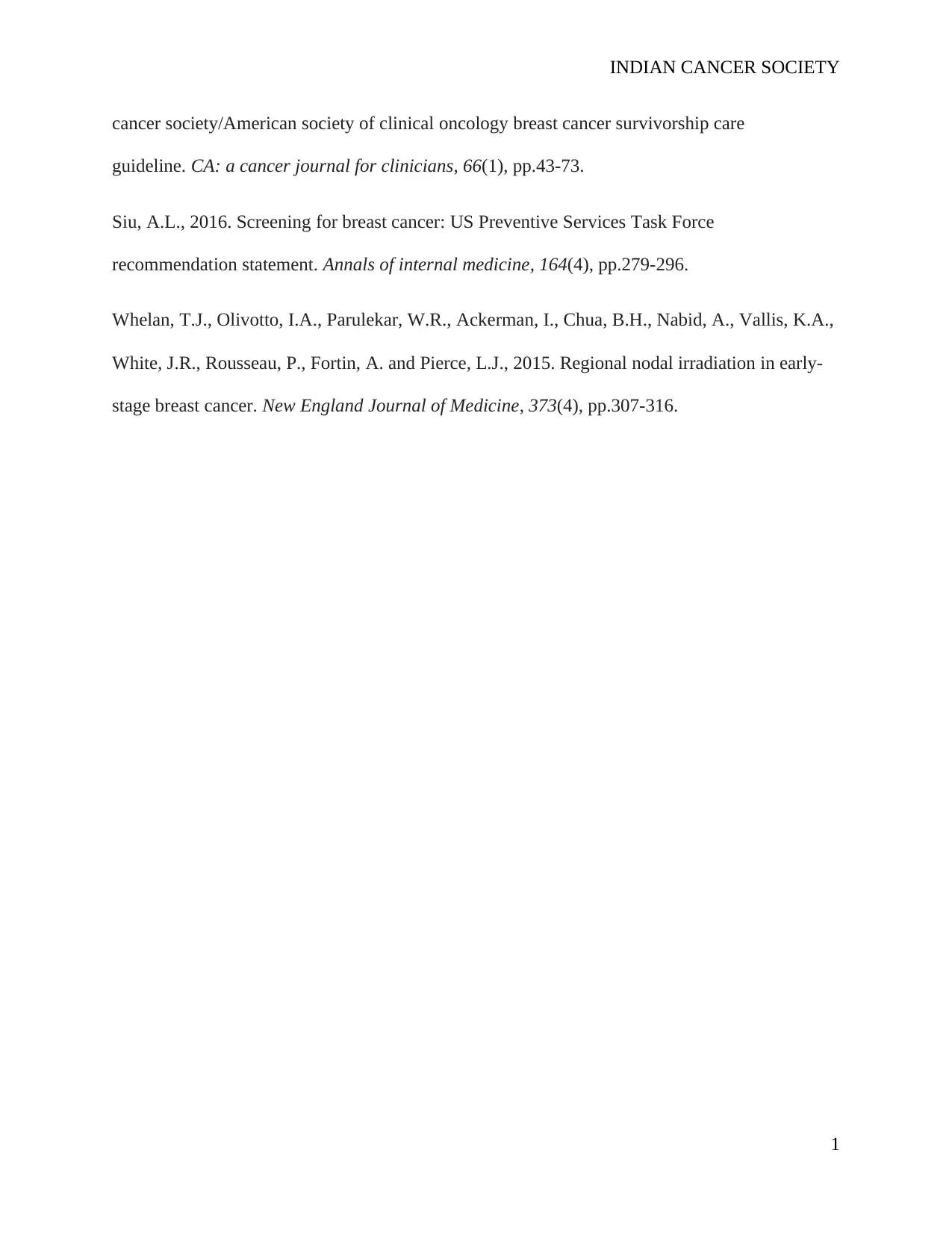
INDIAN CANCER SOCIETY
cancer society/American society of clinical oncology breast cancer survivorship care
guideline. CA: a cancer journal for clinicians, 66(1), pp.43-73.
Siu, A.L., 2016. Screening for breast cancer: US Preventive Services Task Force
recommendation statement. Annals of internal medicine, 164(4), pp.279-296.
Whelan, T.J., Olivotto, I.A., Parulekar, W.R., Ackerman, I., Chua, B.H., Nabid, A., Vallis, K.A.,
White, J.R., Rousseau, P., Fortin, A. and Pierce, L.J., 2015. Regional nodal irradiation in early-
stage breast cancer. New England Journal of Medicine, 373(4), pp.307-316.
1
cancer society/American society of clinical oncology breast cancer survivorship care
guideline. CA: a cancer journal for clinicians, 66(1), pp.43-73.
Siu, A.L., 2016. Screening for breast cancer: US Preventive Services Task Force
recommendation statement. Annals of internal medicine, 164(4), pp.279-296.
Whelan, T.J., Olivotto, I.A., Parulekar, W.R., Ackerman, I., Chua, B.H., Nabid, A., Vallis, K.A.,
White, J.R., Rousseau, P., Fortin, A. and Pierce, L.J., 2015. Regional nodal irradiation in early-
stage breast cancer. New England Journal of Medicine, 373(4), pp.307-316.
1
⊘ This is a preview!⊘
Do you want full access?
Subscribe today to unlock all pages.

Trusted by 1+ million students worldwide
1 out of 9
Your All-in-One AI-Powered Toolkit for Academic Success.
+13062052269
info@desklib.com
Available 24*7 on WhatsApp / Email
![[object Object]](/_next/static/media/star-bottom.7253800d.svg)
Unlock your academic potential
Copyright © 2020–2025 A2Z Services. All Rights Reserved. Developed and managed by ZUCOL.
